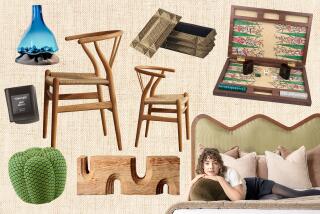DESIGN : It’s OK to Be Mixed Up--Eclecticism Is Without Match as Style Statement
The glamorous striped love seat could be from the ‘30s or ‘40s. In front sits a much less formal antique wicker cocktail table. To one side of the love seat is an elegant gilded armchair upholstered in what looks like faded blue denim. On the other is a French chair with a completely different finish, a whitewashed look.
A decade ago, the room would have been a design nightmare. Now the mix is the height of style, part of Ralph Lauren’s new Marseilles collection.
A major trend, mix and match, has taken over home design.
But call it mix and mix or mix and mismatch--that’s how far the new eclecticism has gone, as gingham marries happily with floral patterns and pewter is used to accent mahogany dining room chairs.
A full-page ad for Pier 1 Imports shows four different chairs pulled up to a dining room table and asks, “Who says everything has to match?” Who indeed?
In New York restaurants, the hottest look is a different china pattern for every place setting.
The current style seems driven by what people are actually doing in their own homes--not just what furniture designers and interior decorators are dictating. A living room might be a collection of a couple of chairs the owners inherited, a contemporary sofa they fell in love with because it was so comfortable, a second-hand Oriental rug and some flea market finds. Somehow the mix works, and furniture designers are turning it into one of the most important trends of the ‘90s.
“We’re into eclecticism for the long haul,” says Nancy High, director of communications for the American Furniture Manufacturers.
In the “conspicuous-consumption ‘80s,” she says, people with money collected singular pieces of furniture they loved. “It cracked the old notion of everything having to match. Now collecting has moved down to the middle class as a means of self-expression.”
Instead of going out and buying a seven-piece bedroom suite the way their parents and grandparents did, many people are surrounding themselves with pieces of furniture they love, acquired over time. If they do go out and buy their furniture all at once, they want the acquired look, so they deliberately buy mismatched pieces.
The new eclecticism differs from the old eclecticism only in how far it goes. It was always OK to mix periods if you did it properly--but it was understood that certain styles mixed well and others didn’t. You might mix patterns, but there was always a unifying element.
Now just about anything goes, as long as it gives you the feeling you want.
Another reason for the trend toward eclecticism is the value Americans put on comfort these days. According to spokesmen and designers, the single most important consideration for people furnishing their homes these days is comfort. Many people are spending more time at home and don’t want to replace the things they’re comfortable with, even for high design.
They’re also being exposed to many different styles to fall in love with.
Tastes have become more sophisticated because of factors ranging from the proliferation of shelter magazines to the fact that Americans travel more. Affluent Americans have become more used to seeing rooms that reflect a unique style, so they’re more confident about doing it themselves.
Here at home, they’re buying treasures from flea markets and antique shops. And they want to have these things around them to express their individuality.
According to experts, it can work for just about everyone. But if you aren’t an interior designer, you might want to follow these rules for mixing and matching.
Donna Warner, editor in chief of Metropolitan Home, suggests adding one piece at a time. When she redecorated her bedroom, she would bring in an acquisition, live with it, move it around, before she added anything else. “I let it settle in,” she says.
Baltimore designer Madeleine McComas of Arnot & McComas points out that the range of possibilities for mixing fabric patterns is much greater now than even three or four years ago. Let the fabric houses’ guides to coordinating fabrics steer you away from trouble.
“Pick a unifying theme, a glue that holds,” says Stiles Colwill of Colwill-McGehee Antique, Decorative and Fine Arts. For instance, good design can be the cohesive element: “When you’re mixing old and new, quality can hold it together.” Or a color scheme, or a texture, can tie an eclectic room together.
But perhaps the best way to avoid the “Granny’s attic” look is to pay attention to proportion, balance and scale. “If you have a room with overstuffed furniture,” says Jay Jenkins of Alexander Baer Associates, “you can bring in a funky accessory as long as it’s the same weight and strength.”


